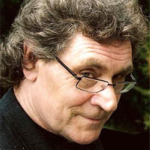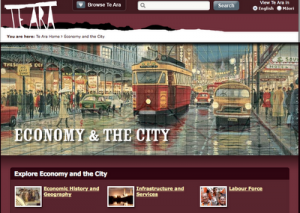
[This week’s guest post is by Paul Reynolds from McGovern Online. Paul is based in Auckland , New Zealand. He consults to the museum library and gallery sector in Australasia. He blogs at People Points. He will be in London in September]
Te Ara – The economy and the city
Last night the rain drummed its way down Queen Street in Auckland, making a small in-road into the humidity of this last week. But that’s Auckland for you – as soon as it has any visitors, especially from Wellington, the rain pours down, the better to confirm their prejudices that it never stops raining here.
The Wellington visitors were a distinguished lot – including Steven Joyce, Minister for Communications and Information Technology, Transport, and Tertiary Education , Louis Holden, the CEO of MCH, the Ministry of Culture and Heritage, and, would you credit, Sir Don McKinnon, the former Secretary to the Commonwealth, 2000-2008,

They were here to help celebrate the next theme of Te Ara , The Economy and the City, from the New Zealand Online Encyclopedia.
Actually, I’m cheating on the last one. although he is/was a long term statesman, both nationally and internationally, last night Sir Don was there as whanau/family – being literally big brother to Malcolm McKinnon, historian, and Te Ara editor of the Places theme.
He in also co-editor of this theme – the Economy and the City, the 6th main theme to this extraordinary piece of cultural practice. The other published topic themes are :
- Maori New Zealanders
- New Zealand Peoples – the arrival and settlement of the people.
- Earth, Sea and Sky – marine life, people and the sea, natural resources, and shaping forces such as geology and climate.
- The Bush – New Zealand’s landforms, fauna and flora.
- The Settled Landscape – farming, rural life, and people’s impact on the land..
Still to come are : Social Connections – social groups, families and communities : Nation– systems of government and symbols of national identity. : Daily Life – the customs, leisure activities and beliefs that make New Zealand unique – and lastly, Arts, culture, invention and innovation.
Each issue, and the combined product represents months of work from the writers, illustrators and designers, as well as a mountain of collaboration with NZ and other museums, galleries and heritage library collections.
Issues and objects of conjecture
I’ve been an admirer of Te Ara since it’s inception, as would anyone who is remotely interested in the life and times of this first class online cultural practice.
This doesn’t mean I am either an uncritical friend, or unconscious of how the direction it took has influenced where it might end up. And how, it might even be time for some radical changes in direction.
Thus way back when it was first mooted as an idea, it would have been lunacy on a stick for Jock Phillips, its Editor and mid-wife – to say to any politician, far less a Prime Minister of Helen Clark’s quality – now head of the UNDP – that if you buy into this idea Minister, you might want to also know we have very little idea of what the online landscape will look like in the next few years, far less the 10 year life of the project, and its entirely probably that we might have to rebuilt the whole thing to keep up with new and emerging online practice.
Are we nearly there yet?
And of course – when we actually get online it will change everything, and there will be little point in asking are we nearly there yet – there is no there – the journey is the destination, and it will be for some time yet.
And even if he had said as much to her, its definitely unlikely he would have foreseen how quickly some passengers have started asking if they can drive the bus, or at least have a go at the map reading.
The critique
So what needs attention? Well for example, in the current site, apart from a good use of RSS feeds, Te Ara has no collaboration tools whatsoever. You can’t make a personalisation folder, and by internal policy fiat there are very few hyper-links links to outside sources. Moreover, you will search in vain for a co-lab rights framework like Creative Commons, or any substantive links to the outside world of social networks.
This lack of an external linking policy has come in for debate in the past. However, I predict there will be a fresh airing of this lack in the weeks to come.
I say this because I believe that creative linking, and enhanced metadata behind the scenes, is now a mandatory part of the linked universe of cultural data.
Linked data – the expectation
Moreover, in the forthcoming semantic web, it will be a commonplace to expect that primary and secondary sources cited in objects like Te Ara – and see any page for brilliant unlinked examples of these – to be machine readable to the digitised primary and secondary sources which it cites. And some of these – see for example the graphs on economic activity, will be live.
As to what kinds of sources are on offer right now, have a look at the excellent work being done by the NZ Electronic Text Centre in digitising NZ primary sources – or the McLean Papers on the NZ National Library of NZ , or indeed over in Australian , see the TROVE gateway to the Australian National Library as an outstanding example of a federated discovery layer, which in turn will take you to digitised copies of the James Cook and Joseph Banks journals, And out in the offing is the prospect of much more to come, including deep linkages to museum collections.
The GLAM thing down under
And just in case you think that the above examples, are a tad library and non museum focussed, its well to remember that down here in the Antipodes there is a much tighter connection between museums, galleries and museums – e.g. TROVE sources from , inter alia, Picture Australia which in turn has a mine of sources from Australian museums.
Similarly museum collection metadata is not only expected, but a common place pillar to the likes of Digital New Zealand, and its older sister Matapihi. Moreover, the likes of The Powerhouse Museum isn’t so much leading the way in discovery and presentation, in the likes of its experiments with Open Calais, its way over the horizon out of sight and sound of the rest of us.
All of which brings us back to my central point that Te Ara not only needs to offer more tools and toys for its visitors to play with – simply told – like so many other online cultural entities – it needs to get out more!
Wikipedia
That said, Te Ara does have a bit of relationship with Wikipedia. Not only will you see Te Ara links in there, its fair to say this is one area in which they could and would do a lot more provided the Wikipedia community started to talk out loud as to how they wanted to frame new kinds of relationships. It would also be great if some for the Wikipedia guys relearned that a conversation works best with at least two sides.
MW2010
Like others, I’m aware of progress in that direction – for example, the Wikipedia guys are heading up and over to the MW2010, Museums and the Web 2010 conference for a session on extending the conversation they started in Canberra last year at the GLAM wiki session.
And on that note, I’d also love to commend the British Museum news that in June this year, they are to host Liam Wyatt as their first volunteer Wikipedian in residence. I think this is a great development.
Creative Commons
Talk about Wikipedia, and you start talking IP rights. Back on Te Ara, there is another huge conversation to be had on their current rights framework.
Basically, like a lot of museums, galleries, etc, they don’t have one. Sure they might think they do – i.e. a re-written analog policy posted on the web site. But as yet – as do almost all the museum sector worldwide – they have still to work out their relationship with the read write generation.
That the Creative Commons framework is a key tool-set in this new relationship is I believe, a given. On that note, here in NZ life for the CC community just got a little interesting.
Royal Society NZ
In an unusual move to say the least, Creative Commons International has endorsed the moving of the NZ CC head licence away from the now defunct NZ Humanities Network into the slightly startled arms of the NZ Royal Society with whom the NZ Humanities Council has now merged.
Local misgivings on the move, mostly from the creative open source community of NZ , have been largely put at rest, not least by the Royal Society’s willingness to set up a new external advisory board which they hope will help them work out how to manage this interesting development.
As someone who was involved in setting up the original framework I was a little dubious as to how sensible it was to send something as fragile as the CC into the stern arms of scientific rigour without at least a basket and a note to be gentile with the baby. But it looks like we should be fine.
The Pacific thing – Pasifika!
Finally, as I tap, its Friday night. I’m heading out tomorrow for Pasifika the annual cultural- arts – and community festival for the Pacific community here in Auckland and beyond. You have no idea how blessed I feel by access to the Pacific way. And as for Pasifika, believe me Notting Hill ain’t got nothing on this.
It runs all weekend. Every island nation has a piece of a local park. Trust me, this is totally the real thing – something that the person who thinks a Samoan tattoo is a good idea will find out tomorrow. And on the kava thing – just how difficult is the concept of a mild narcotic!
Virtual Museum of the Pacific
As for the virtual Pacific – there is a lot more to tell – and maybe next time – if I’m asked back. For the moment – have a look at this You Tube video from The Virtual Museum of the Pacific, here. The site itself is here.
It is one of the most interesting things to cross my desk in a 12 month. Linked data – the new black!
[youtube]http://www.youtube.com/watch?v=YbSgKvWauP8[/youtube]

Comments
I’m so glad we got Paul to contribute a post to the MCG blog. I imagined there might be many more to come as he was keen to weave more connections with the UK (where he was from), to create firmer bonds through collaborative research and innovative projects. We were talking with him about a couple of exciting projects, one in particular, an extraordinary idea of his that really furthered my understanding of what the internet could do for culture, for humanity, not just for museums. So, I was really sad to hear on Sunday that he had died suddenly, from leukaemia he didn’t know he had. There have been many tributes from his NZ colleagues which show he was regarded with enormous respect and fondness. I want to express my condolences to his family and friends.